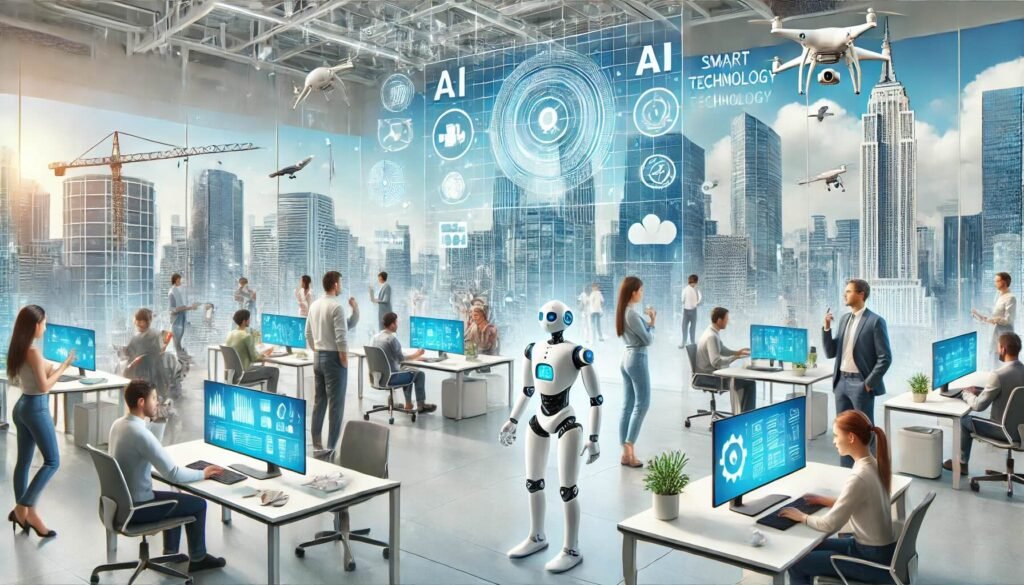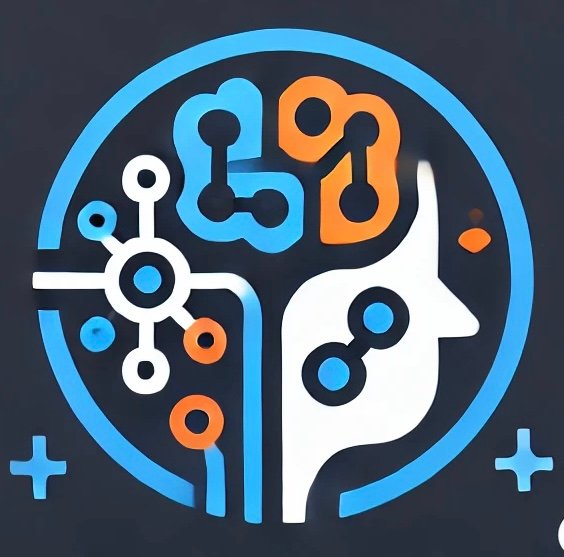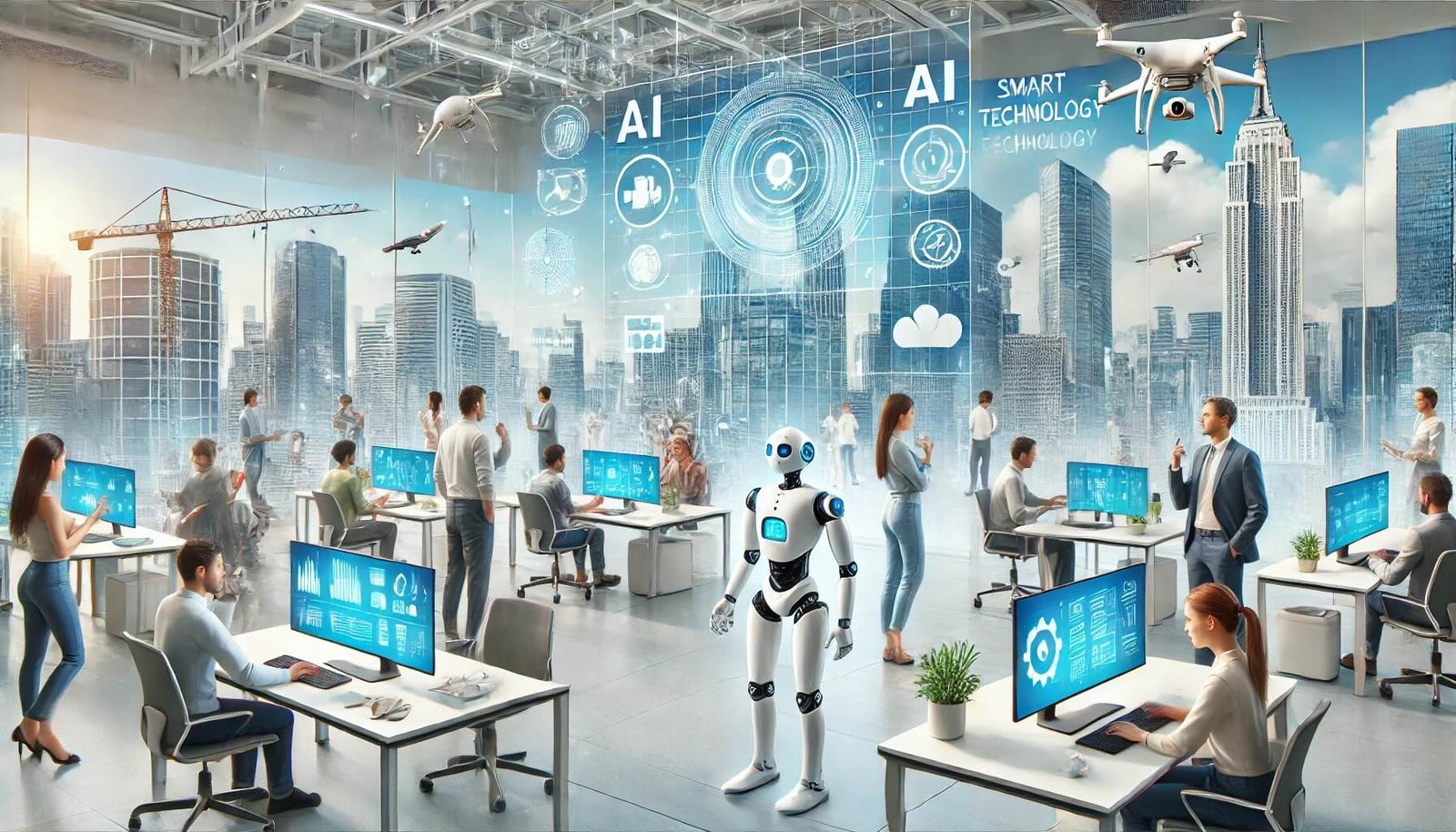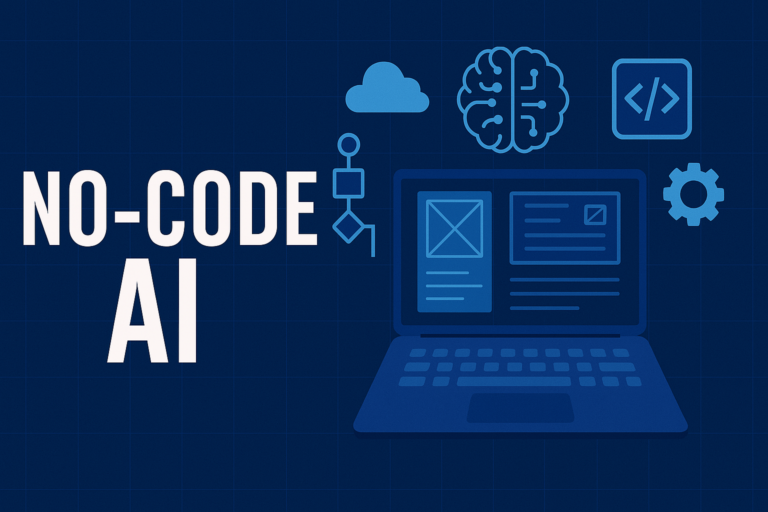
Introduction
AI is no longer the future—it’s the present. How will it reshape your industry?
In early 2025, artificial intelligence has firmly established itself as the driving force behind the most significant workplace transformation since the Industrial Revolution. From healthcare professionals using AI to detect diseases earlier than ever, to retail associates leveraging predictive analytics to create personalized shopping experiences, the future of work AI is already unfolding around us.
What makes this topic particularly important now is the unprecedented acceleration we’ve witnessed. In just the past year, AI adoption has increased by 58% across industries, according to the World Economic Forum’s Future of Jobs Report. Businesses of all sizes are implementing AI solutions that were once reserved for tech giants with massive R&D budgets.
Here’s what you’ll learn in this comprehensive guide:
- How AI is creating more jobs than it eliminates (with concrete examples)
- The specific ways AI is transforming healthcare, finance, manufacturing, and retail
- Practical steps to prepare your business and workforce for AI integration
- Expert predictions on where workplace AI is headed in the next five years
Whether you’re a business leader, an employee concerned about job security, or simply curious about how AI will reshape our professional lives, this article provides actionable insights on navigating the AI-powered future of work.
Table of Contents
Background & Importance
What Exactly Is AI in the Workplace?
When we talk about AI in the workplace, we’re referring to computer systems designed to perform tasks that typically require human intelligence. This includes everything from basic automation tools that handle repetitive tasks to sophisticated machine learning algorithms that can analyze complex data sets and make predictions or recommendations.
Tools like OpenAI’s ChatGPT-5 and Google’s Gemini Ultra are transforming content creation and customer service, while platforms like DataRobot and H2O.ai enable businesses to build custom predictive models without needing an army of data scientists.
The Rapid Pace of AI Adoption
The numbers tell a compelling story about AI industry transformation:
- According to McKinsey’s State of AI 2024 report, 79% of organizations have now implemented AI in at least one business function, up from 58% in 2023.
- Investment in AI technologies reached $207 billion globally in 2024, with projections to exceed $300 billion by 2026 according to IDC research.
- Industries previously slow to adopt digital technologies—like construction, agriculture, and healthcare—are now experiencing the fastest growth in AI implementation.
The workplace automation trends are clear: AI is no longer confined to Silicon Valley or research labs—it’s transforming workflows in factories, hospitals, retail stores, and offices worldwide.
Why AI Transformation Is Inevitable
Dr. Andrew Ng, founder of DeepLearning.AI and former chief scientist at Baidu, summarizes the situation well: “AI is the new electricity. Just as electricity transformed countless industries 100 years ago, AI is now poised to do the same.”
This transformation is inevitable for several reasons:
- Competitive pressure: Companies that don’t adopt AI risk falling behind competitors who can operate more efficiently and respond more quickly to market changes.
- Labour challenges: With ageing populations in many developed economies and skills shortages in key sectors, AI offers solutions to workforce limitations.
- Customer expectations: Today’s consumers expect personalized, efficient service across all touchpoints—something only AI can deliver at scale.
- Environmental imperatives: AI optimization can significantly reduce resource consumption and waste, helping businesses meet sustainability targets.
As Sam Altman, CEO of OpenAI, noted at the 2024 World Economic Forum, “The transition to AI-powered workplaces isn’t optional—it’s a business imperative. The question isn’t whether to adopt AI, but how quickly and strategically to do so.”
Key Benefits & Challenges
Top Benefits of AI in the Workplace
Increased Efficiency and Productivity
AI excels at automating routine tasks, allowing human workers to focus on higher-value activities. For example, JP Morgan implemented a contract review AI called COIN (Contract Intelligence) that can review commercial loan agreements in seconds rather than the 360,000 hours it previously took lawyers and loan officers to complete annually. The future workforce technology improvements don’t stop there:
- Legal professionals using tools like Harvey AI can research case law in minutes instead of days
- Radiologists using Aidoc’s medical imaging AI can review CT scans 32% faster with higher accuracy
- Marketing teams employing Jasper or Copy.ai can generate campaign materials in hours instead of weeks
Cost Savings and Automation
The financial benefits of AI automation jobs are substantial:
- Manufacturing giant Siemens reported 25% cost reductions after implementing AI-powered predictive maintenance in their factories
- Insurance provider Lemonade processes claims up to 3x faster while reducing processing costs by 40% using their AI assistant Jim
- Retail chain Walmart saved $2.3 billion in 2024 by using AI to optimize inventory and reduce waste
Enhanced Decision-Making with AI-Powered Insights
Perhaps the most transformative aspect of AI business impact is the way it enhances human decision-making capabilities:
- Healthcare provider Providence St. Joseph Health uses AI to predict patient deterioration 6-8 hours before traditional methods would detect problems
- Agricultural company John Deere’s machine learning algorithms help farmers make real-time decisions about planting, fertilizing, and harvesting, increasing yields by up to 15%
- Financial services firm Morgan Stanley equipped 16,000 financial advisors with AI assistants that analyze vast amounts of research to provide better investment advice
Improved Customer Experiences
AI is redefining customer service and experience:
- Bank of America’s virtual assistant Erica now handles 1.5 million customer interactions daily, with a 90% successful resolution rate
- Starbucks’ Deep Brew AI platform analyzes purchase history to make personalized recommendations, increasing average order value by 14%
- Telecom provider T-Mobile reduced customer service wait times by 60% using AI-powered chatbots and routing systems
New Job Opportunities in AI Development and Ethics
While some jobs are being transformed, the AI skills demand is creating entirely new career paths:
- LinkedIn reports that AI specialist roles grew by 74% annually over the past four years
- Roles like “AI Ethics Officer” and “Machine Learning Operations Engineer” simply didn’t exist five years ago
- The Bureau of Labor Statistics projects that employment in computer and information technology occupations will grow 15% from 2021 to 2031, much faster than the average for all occupations
Common Challenges & How to Overcome Them
Job Displacement Concerns and Reskilling Strategies
The concern about employment in the age of AI is legitimate but often misunderstood:
- While the World Economic Forum estimates that 85 million jobs may be displaced by 2025, it also projects that 97 million new roles will emerge
- The nature of jobs is changing rather than disappearing entirely
- Companies like Amazon, IBM, and AT&T have invested billions in reskilling programs to help employees transition to AI-complementary roles
Successful strategies include:
- JPMorgan Chase’s “New Skills at Work” initiative provides employees with technical training
- Microsoft’s Professional Program for Artificial Intelligence offers specialized training paths
- Google’s “Grow with Google” program provides free AI skills training to workers across industries
Ethical Concerns and Bias in AI Decision-Making
As AI systems make more consequential decisions, ethical issues have come to the forefront:
- Amazon had to abandon an AI recruiting tool that showed bias against women
- Facial recognition technologies have demonstrated higher error rates for people with darker skin tones
- Credit-scoring algorithms have been found to disadvantage certain demographic groups
Organizations addressing these challenges effectively include:
- IBM’s AI Ethics Board establishing clear principles for responsible AI development
- Microsoft requires diversity in training data and regular bias audits
- The Partnership on AI (including companies like Apple, Amazon, and Facebook) developing best practices for fair AI implementation
Integration Costs and Infrastructure Challenges
Implementing AI systems can be costly and complex:
- Enterprise AI projects average $500,000 to $5 million in initial investment
- Legacy systems often require significant upgrades to support AI capabilities
- Technical expertise remains in short supply
Solutions include:
- Starting with smaller, targeted AI projects to demonstrate ROI before scaling
- Cloud-based AI services like AWS SageMaker, Google Cloud AI, and Azure AI reduce infrastructure requirements
- Low-code/no-code AI platforms like DataRobot and H2O.ai make AI more accessible to organizations with limited technical resources
Privacy and Data Security Risks
As AI systems process vast amounts of data, privacy concerns multiply:
- Healthcare AI systems must comply with regulations like HIPAA
- Financial services AI must navigate complex regulatory frameworks
- Consumer-facing AI raises questions about data consent and usage
Best practices include:
- Implementing privacy-by-design principles in AI development
- Using techniques like federated learning that allow AI models to be trained without centralizing sensitive data
- Maintaining clear data governance policies with regular audits and assessments
Real-World Use Cases & Applications
AI in Healthcare: Revolutionizing Patient Care
The healthcare industry is experiencing perhaps the most profound AI business impact:
- Advanced diagnostics: AI systems from companies like Viz.ai can detect strokes from CT scans in under 2 minutes, compared to the 60+ minutes traditionally required, saving critical time for treatment
- Robotic surgeries: Intuitive Surgical’s da Vinci system has performed over 10 million procedures worldwide, with studies showing reduced recovery times and complications
- Drug discovery: Insilico Medicine used its AI platform to identify a novel drug candidate for pulmonary fibrosis in just 18 months, compared to the typical 4-5 years
- Personalized treatment plans: Mayo Clinic partnered with Google to develop AI systems that analyze patient records to recommend individualized treatment protocols
Dr. Eric Topol, cardiologist and founder of the Scripps Research Translational Institute, notes: “AI won’t replace doctors, but doctors who use AI will replace those who don’t. The technology enhances our capabilities while allowing us to focus more on the human aspects of care.”
AI in Finance: Transforming Transactions and Trust
The financial sector’s adoption of artificial intelligence in business has been aggressive and wide-ranging:
- Fraud detection: PayPal’s AI systems analyze millions of transactions per day, reducing fraud rates by 30% while improving legitimate transaction approvals
- Risk assessment: Upstart’s AI lending platform evaluates borrower risk beyond traditional credit scores, resulting in 53% more approvals and 75% fewer defaults compared to traditional models
- Algorithmic trading: Renaissance Technologies’ Medallion Fund, powered by sophisticated machine learning algorithms, has averaged over 70% annual returns (before fees) for over 30 years
- Client service: Bank of America’s Erica virtual assistant handled over 1 billion client interactions in its first three years, answering questions and executing transactions
“Financial services may be the industry most transformed by AI in the next decade,” says Jamie Dimon, CEO of JPMorgan Chase. “From risk management to customer service, the entire value chain is being reimagined.”
AI in Retail: Personalizing at Scale
Retail has embraced AI to enhance both online and in-store experiences:
- Personalized shopping: Amazon’s recommendation engine drives 35% of its sales through personalized suggestions
- Inventory management: Zara uses AI to analyze store sales, customer feedback, and even social media trends to determine production quantities, reducing excess inventory by 50%
- Visual search: H&M’s AI-powered visual search allows customers to upload images and find similar items in their catalogue
- Dynamic pricing: Best Buy implements AI-driven dynamic pricing that adjusts over 20 million times per month based on competitor pricing, inventory levels, and demand patterns
“Retail AI isn’t just about efficiency—it’s about creating experiences that were simply impossible before,” explains Doug McMillon, CEO of Walmart. “We’re using these technologies to know our customers better than ever and serve them in ways that were science fiction just a few years ago.”
AI in Manufacturing: Building the Factories of Tomorrow
Manufacturing has embraced workplace automation trends through AI implementations:
- Smart factories: Siemens’ Amberg Electronics Plant uses AI to automate 75% of its production value chain, achieving 99.9% quality rates
- Predictive maintenance: ArcelorMittal uses AI systems that analyze sound and vibration data to predict equipment failures weeks before they occur, reducing downtime by 50%
- Supply chain optimization: Unilever implemented AI across its supply chain, resulting in $370 million in savings while reducing delivery times by 10%
- Quality control: BMW uses computer vision AI to inspect every vehicle component, detecting defects at 99.8% accuracy compared to 92% with human inspection
Klaus Schwab, founder of the World Economic Forum, observed: “In manufacturing, AI isn’t simply changing how we make things—it’s changing what we can make and reimagining the limits of production.”
Expert Insights & Thought Leadership
Industry Leaders on AI’s Future Impact
The conversation about the future of work AI is being shaped by leaders across industries:
Satya Nadella, CEO of Microsoft, explains their approach: “At Microsoft, we’re focused on developing AI that amplifies human ingenuity. The most powerful AI systems will be those that complement human capabilities rather than replacing them.”
Jensen Huang, CEO of NVIDIA, offers a broader perspective: “AI is creating a new industrial revolution. Every industry—from healthcare to retail to manufacturing—is being reimagined with intelligence at its core.”
Ginni Rometty, former CEO of IBM, focuses on workforce implications: “The debate shouldn’t be about humans versus machines, but about how we create systems where humans and AI collaborate effectively. We call this ‘augmented intelligence’ rather than ‘artificial intelligence.'”
Comparing AI Adoption Strategies
Different industries are taking varied approaches to AI integration:
- Healthcare: Tends to implement AI incrementally, focusing first on administrative and operational efficiencies before moving to clinical applications
- Financial services: Often creates separate innovation labs or digital subsidiaries to develop AI solutions that are later integrated into the parent organization
- Manufacturing: Typically follows a pilot-test-scale model, starting with single production lines before expanding successful implementations
- Retail: Frequently adopts a hybrid approach, implementing proven AI solutions from vendors while developing proprietary systems for competitive advantage
According to research from Deloitte’s Global AI Study, organizations with the most successful AI implementations share three common traits: clear executive sponsorship, cross-functional implementation teams, and a focus on solving specific business problems rather than implementing AI for its own sake.
Predictions from Research-Backed Reports
The most credible forecasts about future workforce technology point to several key trends:
- The McKinsey Global Institute predicts that by 2030, up to 30% of hours worked globally could be automated, but also that total employment may increase as new roles emerge
- Gartner Research projects that 80% of customer interactions in financial services will be handled by AI by 2026
- The International Federation of Robotics forecasts that collaborative robots working alongside humans will grow at a CAGR of 42% through 2026
Perhaps most importantly, a comprehensive Stanford University study concludes that the greatest value will come from human-AI collaboration rather than pure automation: “The future belongs to neither humans alone nor AI alone, but to new workflows that combine human judgment with machine efficiency.”
Step-by-Step Guide or Action Plan
How Businesses Can Prepare for AI Integration
Successful AI industry transformation requires methodical planning and implementation:
- Assess current capabilities and needs
- Audit existing processes to identify pain points and inefficiencies
- Evaluate data infrastructure and quality
- Inventory employee skills related to AI and data science
- Develop a clear AI strategy
- Align AI initiatives with broader business objectives
- Prioritize use cases based on potential impact and feasibility
- Establish metrics to measure success
- Build necessary infrastructure
- Implement data governance frameworks
- Develop or acquire necessary computing resources (cloud-based solutions like AWS, Google Cloud, or Azure often provide the most flexibility)
- Create processes for data collection, cleaning, and preparation
- Start with pilot projects
- Select high-impact, low-risk applications as starting points
- Implement in controlled environments
- Document learnings for broader rollout
- Scale successful implementations
- Expand proven solutions across the organization
- Create centres of excellence to share best practices
- Develop standardized approaches to common AI challenges
Checklist for AI Adoption
✓ Executive sponsorship secured ✓ Cross-functional implementation team established ✓ Clear business objectives defined ✓ Data quality and availability assessed ✓ Necessary technical infrastructure in place ✓ Ethical framework for AI use developed ✓ Employee communication plan created ✓ Success metrics established ✓ Pilot project scope defined ✓ Evaluation and scaling plan prepared
Steps for Upskilling Employees for an AI-Driven Workplace
The AI skills demand requires a proactive approach to workforce development:
- Assess current and future skill needs
- Map existing employee skills
- Identify gaps based on planned AI implementations
- Prioritize skills development based on strategic importance
- Develop targeted learning paths
- Create role-specific training programs
- Combine formal education with on-the-job learning
- Partner with educational institutions and online learning platforms like Coursera, edX, or Udacity
- Provide continuous learning opportunities
- Allocate dedicated time for skills development (companies like Google and 3M famously allow 20% time for personal projects and learning)
- Create internal communities of practice
- Recognize and reward skills acquisition
- Implement mentoring and knowledge-sharing
- Pair technically skilled employees with domain experts
- Create rotational programs across departments
- Document and share learnings from AI implementations
- Build an AI-positive culture
- Celebrate automation successes
- Emphasize how AI enhances rather than threatens jobs
- Involve employees in identifying automation opportunities
AT&T’s Future Ready program serves as an excellent model, having invested over $1 billion to retrain 100,000+ employees for new technology roles, with many moving from hardware-focused positions to software and data science roles supporting AI initiatives.
Common Myths & Misconceptions
Myth #1 – AI Will Replace All Jobs
The concern: Automation will lead to mass unemployment as machines take over human work.
The reality: AI will augment human roles rather than replace them entirely. The World Economic Forum’s Future of Jobs Report found that while 85 million jobs may be displaced by 2025, 97 million new roles will emerge that are better adapted to the new division of labour between humans, machines, and algorithms.
What we’re seeing in practice:
- Bank tellers weren’t eliminated by ATMs—their roles evolved to focus on customer relationships and complex transactions
- Radiologists using AI diagnostic tools can review more images with greater accuracy, focusing their expertise on complex cases
- Factory workers are becoming robot supervisors and maintenance specialists rather than being replaced entirely
As Erik Brynjolfsson, Director of the Stanford Digital Economy Lab, explains: “The most valuable firms of the future will be those that find ways to leverage human creativity and judgment with machine intelligence and efficiency.”
Myth #2 – Only Tech Industries Will Be Affected
The concern: AI is primarily relevant to technology companies and sectors.
The reality: AI is impacting healthcare, finance, retail, and even creative fields at an accelerating pace.
Some of the most dramatic transformations are happening in traditionally “non-tech” industries:
- Construction company AECOM uses AI to design buildings that optimize energy efficiency and space utilization
- Agricultural equipment manufacturer John Deere uses computer vision and machine learning for precision farming
- Luxury fashion house Burberry employs AI for inventory management and personalized marketing
- Law firm Allen & Overy uses natural language processing to review contracts, reducing 1,500 hours of human work to just seconds
“Every company is becoming a technology company,” notes Marc Benioff, CEO of Salesforce. “AI is becoming embedded in products and services across all industries, not just traditional tech.”
Myth #3 – AI is Too Expensive for Small Businesses
The concern: Only large enterprises with big budgets can benefit from AI technologies.
The reality: Affordable AI solutions are emerging for small and medium businesses through cloud services, APIs, and specialized applications.
Small business AI success stories:
- Restaurant chain Bareburger reduced food waste by 80% using an AI inventory management system that costs less than $200/month
- Boutique marketing agency Hawke Media uses AI content tools to serve clients at 30% lower costs than traditional approaches
- Independent financial advisor Facet Wealth leverages AI platforms to offer personalized financial planning at scale
- Local retailer Neighborhood Goods uses AI-powered analytics to optimize store layouts and inventory
“The democratization of AI through cloud platforms and pre-built solutions means businesses of all sizes can now leverage these technologies,” explains Diane Greene, former CEO of Google Cloud. “What was once the domain of tech giants with massive R&D budgets is now accessible to almost any organization.”
Future Trends & Predictions
AI’s Role in Remote Work and Hybrid Workforce
The COVID-19 pandemic accelerated remote work adoption, and AI is now shaping the future of distributed teams:
- Virtual collaboration tools like Microsoft Teams are incorporating AI assistants that can transcribe meetings, extract action items, and even participate in brainstorming
- Companies like GitLab and Automattic use AI to manage asynchronous workflows and coordinate teams across time zones
- HR platforms like Workday and BambooHR are implementing AI to optimize team formation and monitor employee engagement in remote settings
“The future workplace will be neither fully remote nor fully in-office,” predicts Darren Murph, Head of Remote at GitLab. “AI will be the connective tissue that makes hybrid models work, ensuring consistent experiences regardless of location.”
Rise of AI-Driven Leadership and Decision-Making
Executive decision-making is being transformed by artificial intelligence in business:
- C-suite AI assistants from companies like Palantir and Aera Technology are providing real-time scenario analysis for strategic decisions
- Board management software now includes AI components that analyze risks and opportunities
- Leadership development programs at companies like IBM and Unilever incorporate AI simulations to build decision-making skills
According to a Harvard Business Review study, companies that effectively combine human judgment with AI decision support outperform both AI-only and human-only approaches by 61% in complex decision scenarios.
Ethical AI Development and Regulations
As AI becomes more pervasive, the regulatory and ethical landscape is evolving rapidly:
- The EU’s AI Act represents the world’s most comprehensive regulatory framework for artificial intelligence
- Industry groups like the Partnership on AI are developing standards for responsible development
- Companies like Microsoft and Google have established AI ethics boards with real authority to approve or reject projects
“The next five years will see a maturation of AI governance similar to what we saw with environmental regulations in the 1970s,” predicts Kate Crawford, author of “Atlas of AI” and Microsoft Research principal. “Organizations that proactively address these issues will have a significant competitive advantage.”
AI-Driven Innovation in Education and Skills Training
The education sector is being reimagined through AI applications:
- Adaptive learning platforms like Khan Academy’s Khanmigo personalize instruction based on individual learning patterns
- Companies like Coursera and edX use AI to recommend skills development paths based on career goals
- Corporate training programs increasingly incorporate AI simulations and virtual reality for experiential learning
“AI won’t replace teachers, but it will fundamentally change how and what we teach,” explains Sal Khan, founder of Khan Academy. “The focus will shift from memorization to critical thinking, creativity, and human connection—the areas where people will continue to excel beyond machines.”
Conclusion & Call to Action
Key Takeaways on the Future of Work AI
As we’ve explored throughout this article, AI is reshaping the future of work in profound ways:
- AI augmentation of human capabilities is creating more value than pure automation
- Every industry—not just technology—is experiencing AI-driven transformation
- The most successful organizations are those that pair AI implementation with workforce development
- Ethical considerations and responsible AI development are becoming competitive advantages
- Small businesses can and must leverage AI to remain competitive
The future workforce technology landscape will continue to evolve rapidly, but the fundamental principle remains: AI is a tool to enhance human potential rather than replace it.
Embracing the AI-Powered Future
To thrive in this new era, consider these final recommendations:
- Stay informed: Follow publications like MIT Technology Review, Harvard Business Review, and industry-specific journals to keep up with AI developments relevant to your field
- Develop an AI mindset: Begin thinking about business challenges in terms of data and patterns that could be addressed through AI
- Start small but think big: Implement modest AI solutions that address specific pain points while developing a broader vision for transformation
- Invest in people: Remember that technology alone isn’t enough—your workforce’s ability to leverage AI will determine your success
As Andrew Ng wisely noted, “AI is the new electricity.” Just as electricity transformed every industry a century ago, AI is now powering a similar revolution in how we work, create value, and solve problems.
The organizations and individuals who embrace this transformation—who learn to harness AI’s capabilities while focusing human talent on creativity, judgment, and interpersonal skills—will define the future of work in 2025 and beyond.
Additional resources on AI trends and workforce transformation:




